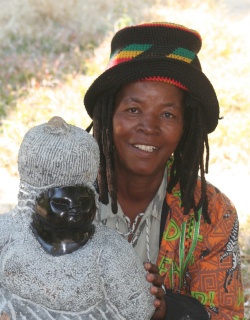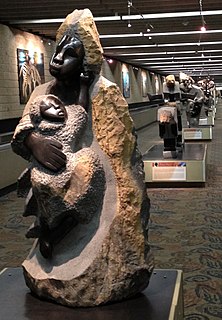Related Research Articles

Bulawayo is the second largest city in Zimbabwe, and the largest city in the country's Matabeleland region. The city's population is disputed; the 2012 census listed it at 653,337, while the Bulawayo City Council claimed it to be about 1.2 million. Bulawayo covers an area of about 1,707 square kilometres in the western part of the country, along the Matsheumhlope River. Along with the capital Harare, Bulawayo is one of two cities in Zimbabwe that is also a province.

Yvonne Vera was an author from Zimbabwe. Her first published book was a collection of short stories, Why Don't You Carve Other Animals (1992), which was followed by five novels: Nehanda (1993), Without a Name (1994), Under the Tongue (1996), Butterfly Burning (1998), and The Stone Virgins (2002). Her novels are known for their poetic prose, difficult subject-matter, and their strong women characters, and are firmly rooted in Zimbabwe's difficult past. For these reasons, she has been widely studied and appreciated by those studying postcolonial African literature.
Berry Bickle is a Zimbabwean artist who resides in Maputo. Born in Bulawayo, Bickle attended the Chisipite Senior School in Harare. Later, she attended the Durban Institute of Technology, where she obtained a national diploma in fine arts, and South Africa's Rhodes University, where she obtained a master's degree in fine arts. Bickle was a founding member of Bulawayo's Visual Artists' Association.

Tapfuma Gutsa is a Zimbabwean sculptor.
Nicholas Mukomberanwa was a Zimbabwean sculptor and art teacher. He was among the most famous products of the Workshop School at the National Gallery of Zimbabwe and an art mentor and teacher to the Mukomberanwa Family of sculptors. His work has been exhibited in galleries around the world and he remains one of Zimbabwe's most famous artists.

Joram Mariga has been called the “Father of Zimbabwean Sculpture” because of his influence on the local artistic community starting in the 1950s and continuing until his death in 2000. The sculptural movement of which he was part is usually referred to as “Shona sculpture”, although some of its recognised members are not ethnically Shona.
Joseph Ndandarika was a Zimbabwean sculptor known for his figurative works.

Colleen Madamombe was a Zimbabwean sculptor working primarily in stone. Her work expresses themes of womanhood, motherhood, and tribal Matriarchy.
Fanizani Akuda, also known as Fanizani Phiri, was a member of the sculptural movement usually called "Shona sculpture", although he and some others of its recognised members were not ethnically Shona. He worked initially at the Tengenenge Sculpture Community, 150 km north of Harare near Guruve, which he joined in 1966.

Agnes Nyanhongo is a Zimbabwean stone sculptor.
Sokari Douglas Camp CBE is a London-based artist who has had exhibitions all over the world and was the recipient of a bursary from the Henry Moore Foundation. She was honoured as a Commander of the Order of the British Empire (CBE) in the 2005 Birthday Honours list.

David Coltart is a Zimbabwean lawyer, Christian leader and politician. He was a founding member of the Movement for Democratic Change when it was established in 1999 and its founding secretary for legal affairs. He was the Member of Parliament for Bulawayo South in the House of Assembly from 2000 to 2008, and he was elected to the Senate in 2008. He is the Legal Secretary for the formation of the Movement for Democratic Change led by Welshman Ncube. He was the Minister for Education, Sport, Arts and Culture from February 2009 until August 2013.
Zimbabwean art includes decorative esthetics applied to many aspects of life, including art objects as such, utilitarian objects, objects used in religion, warfare, in propaganda, and in many other spheres. Within this broad arena, Zimbabwe has several identifiable categories of art. It is a hallmark of African cultures in general that art touches many aspects of life, and most tribes have a vigorous and often recognisable canon of styles and a great range of art-worked objects. These can include masks, drums, textile decoration, beadwork, carving, sculpture, ceramic in various forms, housing and the person themselves. Decoration of the body in permanent ways such as scarification or tattoo or impermanently as in painting the body for a ceremony is a common feature of African cultures.

Sculpture and in particular stone sculpture is an art for which Zimbabwe is well known around the world.
Celia Winter-Irving, was an Australian-born, Zimbabwean-based artist and art critic who wrote extensively on Zimbabwean art, especially Shona sculpture, when she lived in Harare from 1987 to 2008.

David Nthubu Koloane was a South African artist. In his drawings, paintings and collages he explored questions about political injustice and human rights. Koloane is considered to have been "an influential artist and writer of the apartheid years" in South Africa.

India-Zimbabwe relations are bilateral relations between India and Zimbabwe.
Vibhor Sogani is an Indian artist and product designer. Born in Jaipur, he has been living and working in New Delhi for the past 25 years. He has worked on several community art projects, the most notable of them being the Sprouts art installation near the AIIMS flyover in New Delhi.
Sadashiv Sathe or Bhau Sathe was an Indian sculptor. His notable works include the 5-metre high statue of Mahatma Gandhi that is part of the main structure of the National Salt Satyagraha Memorial situated at Dandi, Navsari and the 18-foot equestrian statue of Shivaji at the Gateway of India, Mumbai.
Luis Jose Meque Gugumise was born in Province Tete, Mozambique, but started his art career in Zimbabwe where he moved when he was 20 years old because of civil war that was brewing in his home country. He became a major painter in Harare, but unfortunately died young to AIDS.
References
- 1 2 3 4 "1-54 Contemporary African Art Fair". 1-54.com. Retrieved 27 July 2018.
- ↑ "Adam Madebe - The Nordic Africa Institute". nai.uu.se. Retrieved 27 July 2018.
- 1 2 3 4 5 6 "Biography of Adam Madebe, award winning metal sculptor from Zimbabwe". www.inzart.co.uk. Retrieved 17 July 2018.
- ↑ "Rustenberg Welcomes Mahatma Gandhi | Indian Spice AdiShakti Media". www.indianspice.co.za. Retrieved 27 July 2018.
- ↑ "'Hot Seat' (1989) by Adam Madebe sculpture in found objects and mild steel". www.inzart.co.uk. Retrieved 27 July 2018.
- ↑ Elsbeth, Court. "Pachipamwe II: The Avant Garde in Africa?". African Arts. 25 (1). ISSN 0001-9933.
- ↑ "Looking into the Future: Art and the Law in Zimbabwe : The 2010 Lozikeyi Lecture by Senator David Coltart - David Coltart (Official Website)". David Coltart (Official Website). 29 October 2010. Retrieved 27 July 2018.